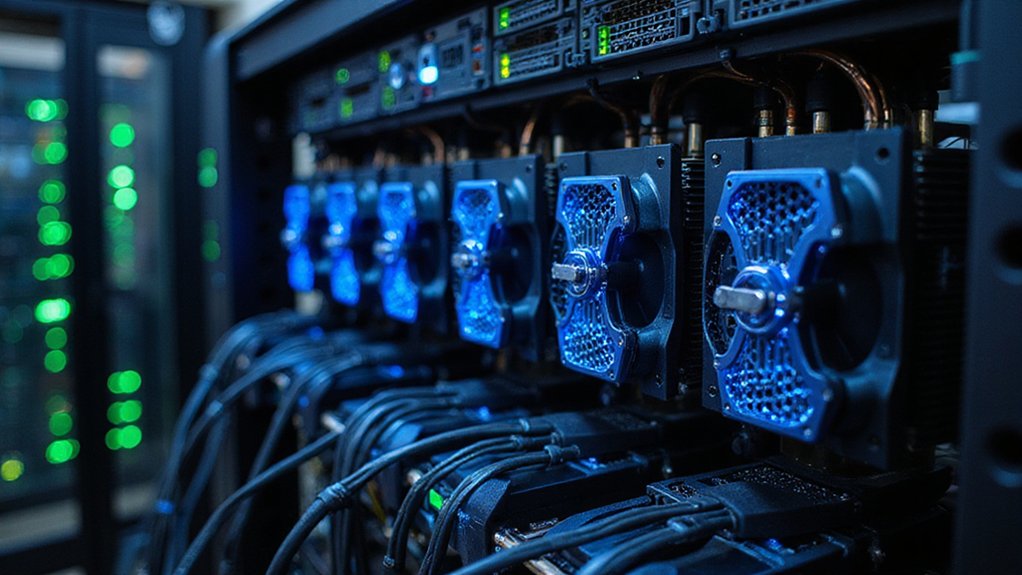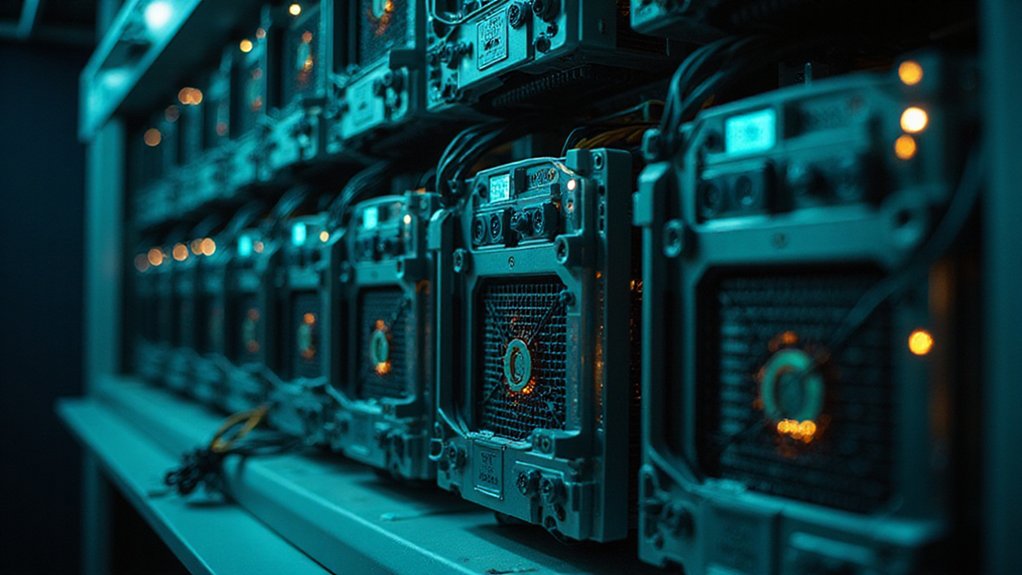ASIC mining represents cryptocurrency’s technological zenith—specialized hardware devices engineered exclusively for specific mining algorithms. These purpose-built machines deliver hash rates that utterly dwarf CPUs and GPUs while consuming substantially less electricity per calculation. Despite requiring substantial initial investment, ASICs have transformed the mining landscape by rendering traditional methods economically obsolete for serious operators. This efficiency revolution comes with trade-offs: centralization concerns and algorithm-specific limitations that skeptics view as undermining crypto’s decentralized ethos. The full picture reveals both remarkable innovation and thorny contradictions.

In the ever-evolving landscape of cryptocurrency mining, Application-Specific Integrated Circuit (ASIC) mining represents both the pinnacle of efficiency and, paradoxically, a point of contention among blockchain purists.
These specialized hardware devices, purpose-built to solve specific cryptographic algorithms, have fundamentally transformed the mining ecosystem by offering performance capabilities that their general-purpose predecessors (CPUs and GPUs) simply cannot match.
The operational principle behind ASIC mining is elegantly straightforward yet technologically sophisticated. ASICs can verify previous transactions and add new blocks to the blockchain network, contributing to the security and functionality of cryptocurrencies.
The elegant simplicity of ASIC mining belies its technological complexity—a perfect marriage of specialized design and singular purpose.
Unlike the versatile but comparatively inefficient general-purpose processors, ASICs are engineered exclusively for particular algorithms—SHA-256 for Bitcoin, for instance—delivering hash rates that dwarf alternative mining approaches while consuming substantially less electricity per calculation.
This remarkable efficiency (could one call it an algorithmic coup d’état?) has rendered traditional mining methods economically unviable for many cryptocurrencies.
The financial calculus of ASIC mining presents a classic investment conundrum.
The substantial initial capital outlay—often several thousand dollars for premium models—must be weighed against the devices’ superior hash rates, reduced power consumption, and potential longevity.
For serious miners, this equation frequently resolves in favor of ASICs, despite their algorithm-specific limitations and vulnerability to technological obsolescence.
Modern ASIC hardware typically comprises a control board, cooling system, and specialized chips arranged to maximize computational efficiency while managing thermal output.
Their plug-and-play nature, coupled with real-time monitoring capabilities, has democratized access to mining operations previously requiring technical expertise.
The proliferation of ASICs has not occurred without controversy.
Critics argue that these devices have accelerated mining centralization by establishing prohibitive barriers to entry, potentially undermining the decentralized ethos fundamental to many cryptocurrencies.
Major cryptocurrencies like Bitcoin and Litecoin rely heavily on the mining operations facilitated by ASICs for their security and transaction verification.
The proof-of-work consensus mechanism that underpins these cryptocurrencies requires miners to solve increasingly difficult puzzles, which are automatically adjusted to maintain consistent block creation times.
Nevertheless, their role in securing blockchain networks through transaction verification remains indisputable.
As cryptocurrency markets mature, ASIC technology continues its inexorable advancement, with manufacturers perpetually pursuing the dual imperatives of increased hash rates and reduced power consumption—a technological arms race showing no signs of abatement in the competitive mining landscape.
Frequently Asked Questions
How Much Electricity Do ASIC Miners Consume?
ASIC miners consume substantial electricity, with high-end models like the Bitmain Antminer S19 Pro drawing approximately 3250W.
Daily consumption varies based on multiple factors: device efficiency, hashrate performance, power supply quality, and operational settings.
Miners typically operate continuously, resulting in significant daily usage—a fact that explains why electricity costs remain the industry’s primary operational concern.
Environmental impact concerns persist as cryptocurrency mining accounts for an estimated 0.6% to 2.3% of annual U.S. electricity consumption.
Can ASIC Mining Be Profitable for Home Miners?
Home ASIC mining profitability hinges on a precarious balance of variables.
While possible under ideal conditions (sub-$0.05/kWh electricity, efficient cooling, minimal network difficulty increases), most domestic miners face an uphill battle against industrial operations.
The calculus becomes increasingly unfavorable as initial hardware investments ($1,000-$10,000) confront diminishing returns, escalating difficulty, and market volatility.
For most households, mining represents less a reliable income stream than an expensive crypto acquisition method with occasional profitability windows.
Are ASIC Miners Legal in All Countries?
ASIC miners aren’t legal in all countries.
Their regulatory status exists on a spectrum—from outright prohibition in China, Algeria, and Morocco to conditional acceptance in the United States, Canada, and parts of Europe.
Many jurisdictions occupy a regulatory gray area, with evolving frameworks addressing environmental concerns, energy consumption, and financial oversight.
The legal landscape remains in flux as governments grapple with cryptocurrency’s implications, often leaving miners maneuvering a patchwork of regional restrictions, licensing requirements, and taxation regimes.
How Loud Are ASIC Mining Machines?
ASIC miners are notoriously loud, typically operating between 50-75 dB (think office noise to vacuum cleaner), with many popular models exceeding 80 dB.
The Antminer S9, a common culprit, can reach a ear-splitting 95+ dB in warmer environments.
This cacophony primarily stems from high-RPM cooling fans and vibrating components—a sound profile that frequently violates residential noise ordinances and has sparked countless neighborly disputes.
Only specialized models like the Jasminer series offer merciful quiet operation.
Can ASIC Miners Be Repurposed for Other Computing Tasks?
ASIC miners present formidable repurposing challenges due to their fundamentally specialized design. Unlike versatile GPUs, these single-algorithm workhorses lack reconfigurability and general-purpose processing capabilities.
Their economic viability in secondary roles is questionable at best, with retrofitting costs typically exceeding anticipated benefits.
While creative alternatives exist—from space heaters to educational tools—these represent marginal use cases rather than true computational repurposing.
The industry has instead pivoted toward infrastructure repurposing, converting mining facilities to host more adaptable hardware like AI accelerators.









